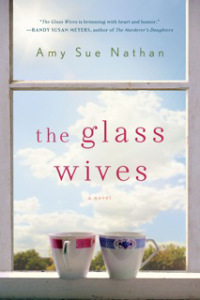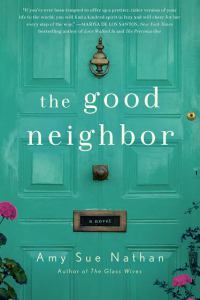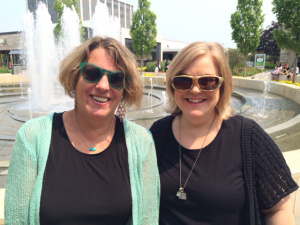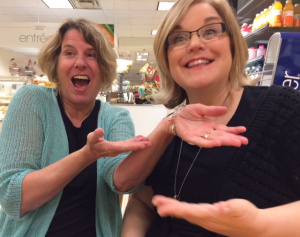Amy Sue Nathan's Blog: Women's Fiction Writers, page 22
September 1, 2015
The Rumors Are True!
And yes, if the rumors are true, then technically, they’re not rumors. But it made a good title, right?
So, do you remember my debut novel, THE GLASS WIVES? The one about the divorced mom who takes in her ex-husband’s young widow and baby?
Well.
The ebook is now $2.99 for Kindle, Nook, iBooks, and Kobo!
If you haven’t read THE GLASS WIVES yet, or if your friend, neighbor, sister, tennis partner, dog groomer, butcher, baker, or candlestick maker hasn’t read it, NOW is the time.
A price discount on a novel is like a red carpet welcome from the publisher to new readers. And with THE GOOD NEIGHBOR launching in SIX weeks, this is a great (and cheap) way to be introduced to a new author!
Here are the links!
And THAT’S NOT ALL!
You can enter to win one of 10 copies of THE GOOD NEIGHBOR on Goodreads until September 12th.
GOODREADS GIVEAWAY for THE GOOD NEIGHBOR
See you soon with more author interviews, guest posts, and information about The Good Neighbor! Oh, and next week? I’m posting a list of my most anticipated books for Fall 2015! You won’t want to miss it!
*MWAH*
Amy xo








August 31, 2015
WFW Audio: A Conversation with Holly Robinson and Amy Sue Nathan
Welcome to the first Audio Post on Women’s Fiction Writers! (It could also be the last if no one else visits me. No guilt though. No pressure either.)
Today, I’m hanging out with my friend, author Holly Robinson (and her very tolerant and easy-going husband) and we talk about writing, and her new novel, Chance Harbor. Then, Holly flips the table and starts asking me questions (sneaky Holly). I think both of us forgot the recorder was on.
And and instead of staring at your monitor, you can eat lunch, fold the laundry, whatever. We’re accommodating that way!
Like THE GOOD NEIGHBOR, Holly’s newest novel, CHANCE HARBOR, doesn’t come out until October, but there are links below so you can find out more. You’re going to be glad I added those links once you hear about the book!
Fair warning, friends…this audio chat is unrehearsed, unedited, and somewhat unrefined. (Which means you’ll probably love it!)
Amy xo
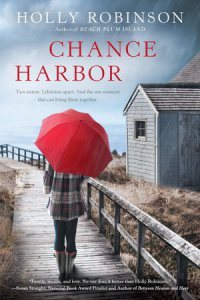 CHANCE HARBOR is available for pre-order on B&N, Amazon, and at your favorite local bookstore.
CHANCE HARBOR is available for pre-order on B&N, Amazon, and at your favorite local bookstore.
Find out more about Holly’s other books by clicking here.
Like and Follow Holly on Facebook! (C’mon, she’s so likable!)








August 26, 2015
Author Interview: Three Questions For Author Lorrie Thomson Who Explores Writing & Inspiration For Her Third Novel
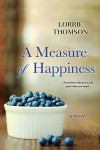 I’m such a rebel. Not really. But today I am sharing something a little different with you, my WFW friends. In celebration of the release of Lorrie Thomson’s third novel, A Measure of Happiness, I’ve asked her THREE things I was very curious about. When I interview any author I ask questions I really want the answers to, figuring if it’s interesting to me, it might be interesting to all of you too.
I’m such a rebel. Not really. But today I am sharing something a little different with you, my WFW friends. In celebration of the release of Lorrie Thomson’s third novel, A Measure of Happiness, I’ve asked her THREE things I was very curious about. When I interview any author I ask questions I really want the answers to, figuring if it’s interesting to me, it might be interesting to all of you too.
Since I’ve read all Lorrie’s books and have interviewed her before, I wanted to dig deeper — a theme of writing women’s fiction, right? So today Lorrie shares with us real insights into how and why she wrote this story, which takes a character from her second novel, What’s Left Behind, and makes her the focus.
Please welcome Lorrie back to WFW and enjoy everything she shares with us today!
Amy xo
Three Questions For Author Lorrie Thomson Who Explores Writing & Inspiration For Her Third Novel
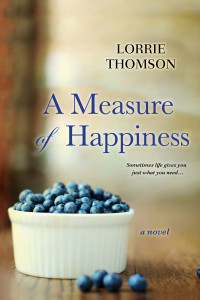 Amy: I’d love to know more about plucking a character from one novel and placing her into the spotlight in another, without the book being a prequel or sequel.
Amy: I’d love to know more about plucking a character from one novel and placing her into the spotlight in another, without the book being a prequel or sequel.
Lorrie: Thanks so much, Amy, for asking me back to Women’s Fiction Writers to discuss A Measure of Happiness!
In A Measure of Happiness, small-town baker Katherine Lamontagne has spent the last twenty-four years giving out cakes and comfort to the citizens of Hidden Harbor, Maine, and keeping the secret of the son she gave away to herself. Until that son comes looking for her, making her reconsider her life and the meaning of family.
This is the first time I’ve returned to a story location and written a novel that contains characters from a previous work. But, even though A Measure of Happiness takes place fifteen years before What’s Left Behind, it’s not considered a prequel. The books are stand-alone novels. And although you’ll likely remember Abby Stone’s best friend, Celeste Barnes, from What’s Left Behind, this is the first time you’re privy to her point of view.
I adore A Measure of Happiness, and I’m so excited to share it with you. But if it weren’t for my agent and editor, I might never have imagined this story. You see, when I passed in the partial manuscript for What’s Left Behind, my agent, Jessica, suggested I come up with an additional story idea. Could I perhaps feature one of the characters from What’s Left Behind? Was there someone from that story I wanted to get to know better?
Celeste, with her fierce loyalty to Abby and her snarky mouth, was the first person who came to mind. In fact, I enjoyed Celeste so much that originally in A Measure of Happiness, hers was the first voice you heard. That’s where my editor came in. While Celeste is a fascinating character with personality to spare, secrets, and lessons to learn, she’s only twenty-two years old. For that reason, during a phone conversation with my editor, Peter, to discuss opening scenes, Peter shared his concern that A Measure of Happiness might be considered NA, New Adult. “Okay,” I said, “I’ll start over.” To that Peter replied, “Don’t start over. Just flip the scenes so that Katherine’s point of view comes first.”
I flipped the scenes.
I’m really glad that I took Peter’s advice. Because even though I’d spent a lot of time thinking about Celeste, her issues, and her back story, I hadn’t yet fully considered Katherine. Luckily, when I asked Katherine nicely, she was more than willing to share her secrets with me, too. She told me about the son she gave away for adoption, and the way that one event had shaped her life. She told me the real reasons she’d divorced Barry, a man she so obviously still loved. And she told me about the ghost from her past, the legacy of shame from a childhood that haunted her.
In A Measure of Happiness, Katherine isn’t the only character with secrets and shame. We all walk around with voices in our heads. Sadly, those voices often tend toward the negative, and Celeste’s inner monologue is no exception. For Celeste these voices, also known as the not-so-nice lies we tell ourselves, lead her to seek relief that’s neither healthy nor uplifting. Yet through it all, she keeps her signature snark and sense of humor.
In addition to Katherine and Celeste, you’ll get to know Zach Fitzgerald, a newcomer to Hidden Harbor, Maine. Just weeks after Zach’s mother kicks him out of the house—she has her reasons—Zach eats his way through two dozen Casco Bay bakeries, wanders into Lamontagne’s, and changes the course of both women’s lives. But make no mistake, in the end, each character finds his or her own way of making peace with the past.
Amy: So did your thoughts change about the town and characters as you wrote this new novel and ostensibly learned the backstory?
Lorrie: I had great fun going back to Hidden Harbor, Maine, and the events and relationships alluded to in What’s Left Behind. In What’s Left Behind, Celeste is married with two children, and the hardworking owner of a bakery called Sugarcoated. In A Measure of Happiness, she’s young, single, and a long-time employee of Lamontagne’s. Yet same as in What’s Left Behind, one of the most important relationships in her life is with her best friend, Abby Stone. Their conflict comes from Abby’s on-gain, off-again romance with boyfriend Charlie Connors and Celeste’s instinct to protect Abby. In A Measure of Happiness, Celeste is also protective towards Abby’s three-year-old son, Luke. Yes, I had the bittersweet responsibility of bringing Abby and Charlie’s son back to life: the teenager who dies before the opening pages in What’s Left Behind. It should come as no surprise that in A Measure of Happiness, little Luke is quite a flirt.
Amy: Next, I asked Lorrie to share places that inspired A Measure of Happiness and she answered with both words and pictures!
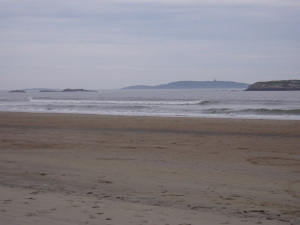
1. Popham Beach in Phippsburg, Maine, where a pivotal scene takes place.

2. View from Fox Island to the Atlantic Ocean. During low tide at Popham Beach, the seas part and you can walk out to Fox Island. But don’t linger too long!

3. View of the Morse Tidal River in Phippsburg, Maine, from the real-life 1877 House. The house and its view inspired the home in Hidden Harbor where Katherine and her ex-husband, Barry, once lived—and where Barry now lives alone.
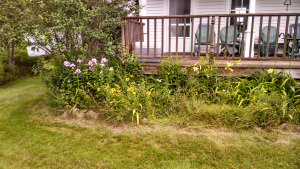
4. Barry’s back porch. Strange, but it wasn’t until I read through proofs that I realized I’d even included the 1877 House’s green metal chairs.
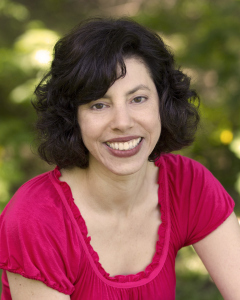 Lorrie Thomson lives in New Hampshire with her husband and their children. When she’s not reading, writing, or hunting for collectibles, her family lets her tag along for camping adventures, daylong paddles, and hikes up 4,000 footers.
Lorrie Thomson lives in New Hampshire with her husband and their children. When she’s not reading, writing, or hunting for collectibles, her family lets her tag along for camping adventures, daylong paddles, and hikes up 4,000 footers.
Visit Lorrie at her website. Connect with her on Twitter and Facebook.








August 17, 2015
Guest Post: Debut Author Kristin Contino On Making An Old Story New Again
 Looking back through a long thread of emails, it seems I met Kristin Contino in 2012 when we were both members of the same author group. Then Kristin reviewed The Glass Wives and came to my Philadelphia area book signing in 2013! I also worked as a freelance editor on one of Kristin’s projects.
Looking back through a long thread of emails, it seems I met Kristin Contino in 2012 when we were both members of the same author group. Then Kristin reviewed The Glass Wives and came to my Philadelphia area book signing in 2013! I also worked as a freelance editor on one of Kristin’s projects.
I’d say we’re intertwined the way only authors can be.
And now Kristin is a debut author!
WAY. TO. GO. KRISTIN!
Today you’ll read how Kristin persevered, wrote through the madness and disappointment, and how THE LEGACY OF US is an old story turned new again— and is published TODAY!
Please welcome Kristin to WFW!
Amy xo
How My Failed First Book Helped Me Sell My Second
By Kristin Contino
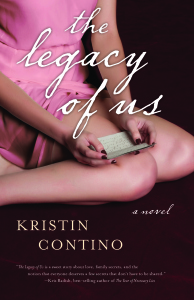 A survey a few years ago uncovered about 80 percent of Americans list writing a book as one of their bucket list items. Tell someone you’ve always wanted to write a book, and she’ll probably agree with you.
A survey a few years ago uncovered about 80 percent of Americans list writing a book as one of their bucket list items. Tell someone you’ve always wanted to write a book, and she’ll probably agree with you.
But when you say you actually are writing a book, it’s a whole new story. Some people will get really excited and ask a ton of questions, while others will give you a “that’s nice” look and think you’re pretty much crazy. But either way, you’ll be hearing one question for a long time.
“How’s The Book coming?” anyone you’ve ever met will say every time you see them. Which is great … if you’ve actually got an update. But when The Book just sputters out and dies, it turns into the last thing you want to talk about.
My first novel started as something I did for fun in my early twenties, and I honestly couldn’t tell you when I first put the words on paper. Like most of my friends, I moved back home after my college graduation. The glamorous PR jobs and Sex and the City lifestyles we’d promised ourselves we’d live seemed like ridiculous dreams in those days after 9/11. The economy had tanked, and the majority of my generation lived in our childhood bedrooms, surrounded by a mix of puffy-painted sorority candles, Titanic posters and stuffed animals, without a clue what we were doing with our lives. So I wrote a story about someone like me.
At first my novel, Homecoming, centered around two girls who’d just graduated and moved back in with their parents. One of them falls for her old college boyfriend, who was already living in the “real world” for a few years and had moved on without her. I wrote in dribs and drabs, sometimes not picking up the manuscript for months, or even years, at a time. I finally found a job in my major, working at a PR firm, and became consumed with my own real world life, just like Adam in my book.
A decent number of people knew I was writing a novel, and between friends and family, I got a lot of “how’s The Book coming?” questions. I’d give vague answers, talking about how I was busy at work, it was hard to find time, but it was “coming along.”
The truth was, somewhere along the line, I fell out of love with my story. And while I’d always been a good writer (and had a degree in it), I didn’t have any kind of fiction training, and writing silly stories about Beverly Hills teens as a kid hardly counted as experience.
I didn’t know where to go next with the plot, and couldn’t imagine writing 60,000-plus more words of a story I felt so meh about. At the time, I didn’t have the maturity to do something about it—like read industry blogs, go to conferences, get a critique partner, or join professional associations like RWA, as I would years later.
So after getting about 15,000 words into the book, I stopped writing.
Life went on, and I did all the things that I expected to do in my mid-to-late twenties: got a new job, traveled with friends, got married. Then, not long before my thirtieth birthday, my story changed completely.
I’d been looking for a cameo necklace for a few months, and had scoured antiques stores and flea markets with no luck. I didn’t want a cheap costume jewelry version, so I decided to hold out until I found something perfect.
My mother-in-law had been going through things at her mom’s house, who had just passed away, and one day a jewelry box ended up in my hands. “I thought this looked like something you’d wear.” And there against the pink velvet sat a vintage cameo pendant, ring and brooch. Exactly what I wanted, but much better. She hadn’t even known I was looking for a cameo.
Back home, I wondered about where the jewelry had come from, and how old the pieces were. And somehow, this random conversation with my husband in the bathroom turned out to be the start of a new book. I’d been feeling the urge to write again, and this concept excited me.
At first, it was a loose idea about a necklace and the different people who acquired it over time. I sat down and realized I wanted it to be about a family, versus strangers who all owned it, and there needed to be a modern-day girl … a girl a lot like Liz, my character from that long-abandoned novel.
Then I thought, why couldn’t it be Liz?
When I sat down and re-read the book, I realized the characters weren’t so much the problem; I loved Liz, and her best friend Addie, and even her sometimes questionable ex-boyfriend. It was the plot that needed work. So I lifted Liz and her friends out of their world and dropped them into a new one, sifting out the dull pieces, and keeping the sparkly ones.
It took a fair amount of tweaking, but I was able to recycle a large part of Homecoming, repurposing the old storyline to fit the new one. Liz aged by five years and lost some of the angst, but not all of it. I added two new POVs: Liz’s grandmother, Ella, and her great-grandmother, Gabriella. I threw myself into reading about Florence in the early 1900s, remembering the places I’d traveled with my friends and imagining my characters there. And suddenly I had a book that I actually wanted to write.
The pages added up each day, and slowly, I started telling people I was working on a novel again. Instead of making me cringe, “How’s The Book coming?” kept me accountable. And this time, I actually had something to say.
It took a few years of writing, querying, and revising more times than I’d like to admit, but that story, The Legacy of Us, was the book that got me my first contract. So if you’ve got a novel under the bed, you never know … it might help lead you to the one.
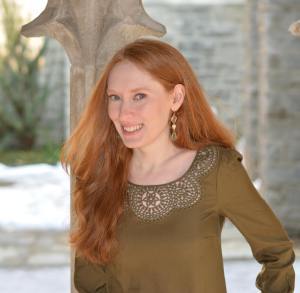 Kristin Contino has been writing stories for as long as she can remember. Her childhood love of reading and writing translated into a career as a freelance writer and editor, and her work has appeared in retail, business, and parenting publications. She lives in the Philadelphia suburbs with her family, but dreams of moving to her favorite city, London. The Legacy of Us is her first novel.
Kristin Contino has been writing stories for as long as she can remember. Her childhood love of reading and writing translated into a career as a freelance writer and editor, and her work has appeared in retail, business, and parenting publications. She lives in the Philadelphia suburbs with her family, but dreams of moving to her favorite city, London. The Legacy of Us is her first novel.
You can find Kristin on the web at www.kristincontino.com, and on Facebook, Twitter and Instagram.
Amazon: http://www.amazon.com/Legacy-Us-Novel-Kristin-Contino/dp/1940716179/ref=sr_1_1?ie=UTF8&qid=1432697394&sr=8-1&keywords=the+legacy+of+us
Barnes and Noble: http://www.barnesandnoble.com/w/the-legacy-of-us-kristin-contino/1121002186?ean=9781940716176








August 12, 2015
Guest Post: Author Diana Bletter Talks About Making Up Words, Writing What You Know, And Living Your Life
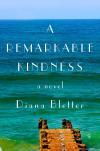 One of the best parts of being an author is reading other authors’ books before they’re published — and sometimes being asked for an endorsement (a compliment, indeed). Such was the case with Diana Bletter’s A Remarkable Kindness. This story — and Diana’s story — are indeed, remarkable.
One of the best parts of being an author is reading other authors’ books before they’re published — and sometimes being asked for an endorsement (a compliment, indeed). Such was the case with Diana Bletter’s A Remarkable Kindness. This story — and Diana’s story — are indeed, remarkable.
Here’s my quote:
“A REMARKABLE KINDNESS, is a story about the bonds of friendship and family; how they are made, broken, and come full circle. Diana Bletter writes with such lush and insightful prose that a foreign landscape and culture becomes warm and familiar. A REMARKABLE KINDNESS explores the power of friendship, love, and ancient traditions, and Bletter’s characters makes you wonder just how far you would go (literally and figuratively) for the people you love.”
Please welcome Diana to WFW!
Amy xo
Making Up Words, Writing What You Know, And Living Your Life
by Diana Bletter
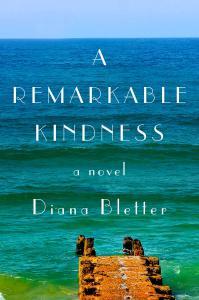 Why is writing so exthrillerating? Because we can take 26 letters (there are 26, right?) and make words line up in perfect order, or fall in place topsy-turvy, or even make up our words, like exthrillerating.
Why is writing so exthrillerating? Because we can take 26 letters (there are 26, right?) and make words line up in perfect order, or fall in place topsy-turvy, or even make up our words, like exthrillerating.
In my novel, A Remarkable Kindness, one of the four main characters, Rachel, invented that word with her high school friend. It’s a powerhouse combo of thrilling and exhilarating and it sums up my feeling exactly about writing this novel.
It’s a privilege for me to write about four women friends. Some writers (presumably male) might say that I’ve relegated myself to a sub-category or run the risk of cutting my potential readership in half. If I had written about four male friends who belonged to a burial circle (more on that in a minute) my novel would be viewed as more encompassing.
We all know that man is the first syllable of mankind. A man can stand for humanity whereas women stand for ourselves. A book about women might not be as appealing to general audiences. It’s obvious that if the series had been called Harriet Potter, it wouldn’t have been so astoundingly successful as what it is now: one young boy’s fight against evil.
Speaking of Harriet, it was Harriet the Spy who introduced me to the idea that I could think of myself as a writer and far more importantly,act like one. Harriet taught me to always, always carry around a notebook and a pen to observe, observe, observe. I’ve learned that what I perceive is valuable. Throughout history, women’s perceptions have been discounted or invalidated. (See Freud, Jung, et al.) We are lucky to live in an era when women don’t have to call ourselves George or Currier to get published. We can be unabashedly women, proudly writing about our own observations and experiences.
A Remarkable Kindness, is about four women who are members of a burial circle in a small beach village in northern Israel. To explain: in 1991, I moved from New York to a village quite similar to the one I’ve invented in my book. The village, founded in 1938, has about one thousand residents. There is a cemetery and a small burial house which serves as the funeral parlor. In keeping with ancient Jewish traditions (picture the shroud of Turin) men prepare and dress a deceased man for burial; women take care of the women. This ritual, called a tahara, has an order to it; there are special, simple clothes, as well as lovely prayers.
I happen to be a member of the burial circle in real life. The word I’d use to describe it? Reverent. One of the novel’s characters, Lauren, is a maternity nurse. She reflects on her great privilege being a witness to the two “bookends of existence,” birth and death. She is surprised to learn that rather than feeling morbid or struck with a depressing sense of mortality after the ritual, she is filled with a craving for life.
The same feeling happened to me with a jolt one specific time after I participated in this ritual. I was aware of the beauty all around me (from the cemetery you can hear the rise and fall of the Mediterranean Sea) and I thought, Wow, I have to write about how life-affirming and wonderful this ritual is. Maybe I’ll write about four women friends who are members of the burial circle. Maybe they’ll talk about life and death. Maybe they’ll reflect on their children, their mothers, their husbands, and….
A Remarkable Kindness took a lot of years, on and off, to write. Life often got in the way as I suppose it does more often to women than to men. (Ah, to have a magic wand perform the shopping, cleaning and cooking.) My husband, Jonny, and I have a blended family of six children, three boys and three girls, and I venture to say (no excuses) that if I hadn’t been carpooling, pairing socks and paring vegetables, I probably would have been able to crank out a few more paragraphs.
But I’ve had the chance not only to write my best chapters but live them, too. And if I’ve learned anything from the novel’s characters—Aviva, Lauren, Emily and Rachel—it’s this: We must really live our lives this time around. We only get one chance.
This is it.

Photo credit: Sigrid Estrada
Diana Bletter’s writing has appeared in a wide variety of publications, including The New York Times, The Wall Street Journal, Family Circle, Glamour, and Commentary. She is the author of The Invisible Thread: A Portrait of Jewish American Women, with photographs by Lori Grinker, nominated for a National Jewish Book Award, and the memoir, The Mom Who Took Off on Her Motorcycle. A native New Yorker and a graduate of Cornell University, Diana lives in a beach village in northern Israel with her husband and children, and volunteers in a burial circle.
http://www.dianabletter.com
http://www.harpercollins.com/9780062382443/a-remarkable-kindness
https://www.facebook.com/DianaBletter
twitter: @dianabletter








August 5, 2015
Guest Post: Author and Scientist Catherine Haustein Combines Women and Science In Her Debut Novel
 As you know, I love bringing you interesting authors who write extraordinary books with many different things motivating them. Today we have Catherine Haustein, scientist and author, sharing her decision to pursue writing in combination with her career as a scientist, and how she came to write her debut novel, Natural Attraction.
As you know, I love bringing you interesting authors who write extraordinary books with many different things motivating them. Today we have Catherine Haustein, scientist and author, sharing her decision to pursue writing in combination with her career as a scientist, and how she came to write her debut novel, Natural Attraction.
Please welcome Catherine Haustein to Women’s Fiction Writers!
Amy xo
Combining Women and Science in Fiction and in Life
by Catherine Haustein
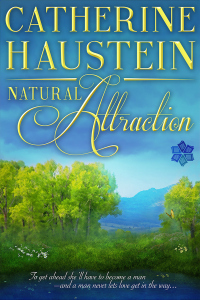 I must admit that I always harbored the goal of being an author who wrote about science. Science is a nation shaper, a life changer, more so now than ever, and so, I reasoned, understanding those who do science would make for great stories. I’m of Dutch decent and thus, pragmatic and it seemed logical to be a scientist first so that I could write what I knew.
I must admit that I always harbored the goal of being an author who wrote about science. Science is a nation shaper, a life changer, more so now than ever, and so, I reasoned, understanding those who do science would make for great stories. I’m of Dutch decent and thus, pragmatic and it seemed logical to be a scientist first so that I could write what I knew.
After a year of pursuing my graduate degree in chemistry at The University of Iowa, I enrolled in the MFA program there without telling my chemistry adviser. I wasn’t going to take “no” for an answer and fortunately, both departments were supportive. Thus my career as a writer of scientist characters was launched.
Writing about science demystifies it. The scientific process isn’t a form of magic. It’s done by normal, flawed human beings. Scientists can be a funny lot so there’s a fountain of material. Writing about scientists gave me a niche too.
Part of why I write about women in science is to encourage others to go beyond society’s limitations. I was told as a girl that science wasn’t for women and I didn’t listen. I’m glad because science is a powerful career choice and can give a person tremendous self-confidence. Good data speaks for you and bestows a sense of worth and wonder.
I have another motivation for writing about science and that’s to entertain scientists and to inspire them to read widely. I worry sometimes, that with all this emphasis on STEM education, we’re not nurturing the souls and creativity of scientists. Suzanne Keen’s study of the connection between reading fiction and developing empathy highlights the need to keep everybody’s nose in a book.
There’s been, however, a nearly Faustian catch in my plans. Once you learn the basics of science, it’s easy to find work and the work is interesting.
I’ve spent most of my career being a scientist—a professor with research on plant chemicals and neurotransmitters.
Ironically, Natural Attraction didn’t begin with science. It began with a place, Singapore, Michigan, now a ghost town, and with a date, 1871.
From this anchor, the science in the novel unfolded and it was mostly biology. I wrote out of my comfort zone as a chemist but this helped me stay in the perspective of a young researcher starting out. It’s got a little plant chemistry in there too, because after all, it’s fun to write what you know.
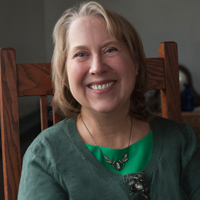 A graduate of the Iowa Writer’s Workshop, Catherine Haustein is a chemistry and English professor at Central College in Iowa. Her ancestors lived in the famous ghost town of Singapore on the shores of Lake Michigan. Natural Attraction is her first novel.
A graduate of the Iowa Writer’s Workshop, Catherine Haustein is a chemistry and English professor at Central College in Iowa. Her ancestors lived in the famous ghost town of Singapore on the shores of Lake Michigan. Natural Attraction is her first novel.
Natural Attraction is an adventure told by Clementine, a young Dutch American scientist in 1871 who must pose as a man to further her career as a naturalist. With the help of a mysterious tonic, she transforms into a man, discovers new species, and falls in love with a preacher.
Buy the book here:
Amazon, iBooks, B&N, Kobo, Lybrary
Find out more about Catherine Haustein here:
Website: http://catherinehaustein.com/
Tumblr: https://www.tumblr.com/blog/catherinehaustein
Pinterest: http://www.pinterest.com/catherinehauste/
Facebook: https://www.facebook.com/catherine.haustein
Twitter: @hausteinc1








August 4, 2015
Guest Post: The Inspiration And Irony Of “Annie Aster” by Scott Wilbanks
Read this essay by THE LEMONCHOLY LIFE OF ANNIE ASTER (which releases today!) author, Scot Wilbanks. You won’t be sorry.
You will be engaged, heartbroken, and inspired.
Amy xo
Inspiration And Irony
by Scott Wilbanks
 I head down to Los Angeles next week for the second leg of my cross country journey, and while I have no intimate connection to that city, other than a smattering of friends, it will be, by far, the most poignant stop on my tour, because of a particular young woman.
I head down to Los Angeles next week for the second leg of my cross country journey, and while I have no intimate connection to that city, other than a smattering of friends, it will be, by far, the most poignant stop on my tour, because of a particular young woman.
You see, there’s a story I must share while I’m there, and I’m afraid it will make her sad. It’s about the inspiration behind my debut novel The Lemoncholy Life Of Annie Aster, and she really needs to hear it.
I still find it baffling that my book—and my career, for that matter—owes its life to such humble and awkward beginnings. But there you have it.
And yet it had all begun so charmingly.
I’d never seen him before that peculiar weekend when our paths crossed five times at my local haunts in San Francisco’s Castro district.
The first of our encounters was so vivid that it even found its way into Lemoncholy’s pages. The passage is a wee bit melodramatic, I’m afraid, but I was walking down the street with my head in a book, had glanced up from the pages just as he walked past, and, well, time kind of stood still.
The cars crawled. A hummingbird inched forward like a slow-motion sequence in a National Geographic special, its wings undulating in the exquisite fashion of a Japanese fan dancer. A dog floated upward in the park across the street, a look of pure joy frozen on its face, eye focused on a Frisbee hovering inches from eager jaws and spinning so slowly that you could read the word Wham-O on it. Then, whoosh… time repaired itself and Christian was walking all too quickly past the face with the secret smile.
It was all a bit of a mystery, those encounters, and as the narrative indicates, I quickly dubbed the object of my fascination “the face,” while finding myself building a story in my head as to who he might be in those odd moments when I wasn’t doing business-y things, or washing dishes, or nodding off in bed with a book in my hands. All I knew for certain was that he was stupidly handsome, a condition that was offset by some pretty ridiculous sartorial choices.
Note to self: NEVER wear an orange flannel button-down over fade brown corduroys.
That face, combined with those clothes, fascinated me. Who was this guy?
In my book, Annie Aster suggests that he could be a “third cousin, twice removed,” or “a killer for hire” who has marked her best friend Christian for liquidation, which only prompts Christian to respond that those options need not be mutually exclusive, considering that he comes from Texas. (Many apologies to any proud Texans reading this. It’s an inside joke, and I do the state proud in the end.)
The fifth of my encounters with “the face” was a perfect illustration that Kismet does, indeed, have a sense of humor. Clearly annoyed that I’d wasted four good opportunities, the universe took a much needed break from its attempted match-making and my life had gotten on with the business of the humdrum for a good week or so, leaving “the face” little more than a memory; that is, until I’d felt a light tapping sensation on my shoulder at the gym. I turned around to find him staring me down with his trademark smile, the one that went through me like catnip. To my surprise, he pointed at my tank top, unraveled a kink in one of its straps, and simply wandered off.
Okay, the universe was not to be denied this time.
I quickly re-tangled the very same strap, tracked him down (politely interrupting the conversation in which he was involved, in the process), and suggested that his efforts lacked conviction.
That got me a laugh and his phone number, and, truth be told, I’d thought everything was going swimmingly, but then my date made it clear that we had separate agendas by rocking back in his chair to declare, “I think we are destined to be great friends.”
Great… friends.
Definitely not the response I was looking for.
Thirty minutes and a cataclysmic decline into tragically boring conversation later, I found myself driving home with my tail tucked firmly between my legs when it occurred to me that things are only inevitable if you accept them as such. By the time I’d pulled into my drive, I’d concocted a pair of characters in my head—Annabelle Aster and Elsbeth Grundy—pen pals who write one another between contemporary San Francisco and Victorian Kansas, depositing letters in a brass letterbox that stands in some common magical ground between the two.
I ran upstairs, whipped up a letter from Annie to Elsbeth in which she asked for advice regarding her love-struck friend—me—and promptly emailed it to my date. I know, right?
Within a couple hours, I received a call. Apparently, my email had made the rounds at his office and was a bit of a hit. More were demanded.
“Sadly, I cannot,” I said.
“Why’s that?”
“Elsbeth hasn’t written back,” I responded, as if nothing could be more obvious.
The next morning, I found an email in my inbox with Elsbeth’s name in the subject line.
Our correspondence became a regular thing. I would write as Annie, talking about Scott’s feelings, my feelings. He would write as Elsbeth, talking about his. Somewhere around the sixth exchange, we’d become an “item.”
A year later, we’d moved in together.
Five years later, his prophecy came true. We found that we were much better suited as friends than lovers. And we became the best of them, very nearly inseparable.
I began writing the first horrible draft of Lemoncholy the following year, a story that, at its heart, is about five misfits who are seeking understanding and enlightenment in an unforgiving world.
Of course, Annie and Elsbeth play the lead—one an eccentric in contemporary San Francisco who refuses to wear anything but Victorian clothes, the other a truculent., old schoolmarm living in turn-of-the-century Kansas.
But there’s also Christian. He’s Annie’s best friend; a young man burdened with a secret buried so deep within his subconscious that it leaves him with a stutter. And there’s Edmond, the charismatic, sweetheart who is weighed down by a demon—drug addiction.
It should come as no surprise, then, that I based Christian off my own life experience, and Edmond’s off my nearly failed date, turned partner, turned best friend.
And… this is the point where I suspect I’ll struggle a bit while sharing my story with the audience.
You see, four weeks after The Lemoncholy Life Of Annie Aster went into production, and just two weeks after I’d spent an hour on Skype, discussing my date’s first international trip to visit me and my husband in New Zealand where I’ve been living for the last six years, I received an email from the young lady who will be attending my reading.
She is my date’s sister—Edmond’s sister.
And she wrote to inform me that he’d passed away. His demon had gotten the better of him.
She’s never heard this story. But she loved her brother fiercely, and deserves to know.
As for me? There’s not a day goes by that I don’t miss him.
And for the curious. He’s in the dedication.
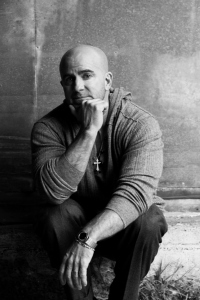 Scott is the author of THE LEMONCHOLY LIFE OF ANNIE ASTER, a commercial fiction novel with a fantasy premise releasing August 4, 2015 that tells the story of two pen pals who are fighting against the clock to solve the mystery behind the hiccup in time connecting their homes before one of them is convicted of a murder that is yet to happen… and yet somehow already did.
Scott is the author of THE LEMONCHOLY LIFE OF ANNIE ASTER, a commercial fiction novel with a fantasy premise releasing August 4, 2015 that tells the story of two pen pals who are fighting against the clock to solve the mystery behind the hiccup in time connecting their homes before one of them is convicted of a murder that is yet to happen… and yet somehow already did.
Scott’s website: http://scottwilbanks.wix.com/scottwil...
More about the book: http://scottwilbanks.wix.com/scottwil...
Twitter: https://twitter.com/scottbwilbanks
Facebook: https://www.facebook.com/scott.wilban...








July 30, 2015
Author Interview: Colleen Oakley Shares Her Hardest Scene And Straightforward Advice For Writers
 Today we’re celebrating the paperback launch of Colleen Oakley’s BEFORE I GO. And before I go on — let me tell you that Colleen has four (coughFOURcough) little kids. And by little I mean two of them are twins. And they’re babies. So when you say or hear someone say (and by say I mean whine) “I don’t have time to write,” tell them about Colleen. Tell them you (and she) have the same 24 hour days that they do.
Then tell them to read BEFORE I GO to see what can be accomplished.
Today we’re celebrating the paperback launch of Colleen Oakley’s BEFORE I GO. And before I go on — let me tell you that Colleen has four (coughFOURcough) little kids. And by little I mean two of them are twins. And they’re babies. So when you say or hear someone say (and by say I mean whine) “I don’t have time to write,” tell them about Colleen. Tell them you (and she) have the same 24 hour days that they do.
Then tell them to read BEFORE I GO to see what can be accomplished.
Below you’ll learn about a paperback vs. a hardcover launch, Colleen’s favorite and hardest scene to write, and her straightforward advice for writers.
Please welcome Colleen to WFW!
Amy xo
Author Colleen Oakley Shares What Readers Have Taught Her About Her Own Book
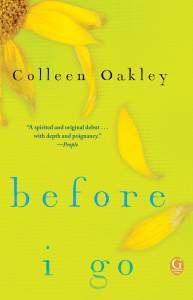 Amy: Congratulations on the paperback launch of BEFORE I GO! Can you explain the process a bit and how it differs from your hardback and initial launch of BEFORE I GO?
Amy: Congratulations on the paperback launch of BEFORE I GO! Can you explain the process a bit and how it differs from your hardback and initial launch of BEFORE I GO?
Colleen: Thank you! The main difference between the hardback launch, which was back in January and the paperback launch (July 14) is that the paperback is a much quieter affair. It got a new cover, which was fun, but there were no big launch parties or tours or major media attention — which on the one hand I missed — the hardback launch was so much fun! But on the other hand, it was also kind of exhausting, so it was nice to just enjoy the day of the paperback launch in my pajamas, sending out a few Tweets and playing board games with my kids.
Amy: Your covers are slightly different. How do you feel about the change and what do you think it will mean for the book?
Colleen: At first, I was taken aback by the shockingly bright colors! I was so used to the subdued hardback cover. But, after staring at it for an afternoon (I left it open on my desktop and looked at it every time I passed my computer), it really grew on me. So many paperbacks get completely different covers, and I was glad mine didn’t change that much, because I love, love, love the flower and what it signifies. But I hope the new bright colors will stand out on the bookshelf and say to would-be buyers: “Pick me! Pick me! I’m the perfect summer read!”
Amy: We learn so much through the publishing process. What’s one thing you’re telling readers (like us) about BEFORE I GO now, that you didn’t when it first launched? Or—vice versa! What aren’t you saying that you said before? ;-)
Colleen: This is a hard question, because I’m kind of an open book (forgive the pun) — I’m happy to tell anyone, anything they want to know! What I’ve loved since the publication of the book is what I’ve learned from readers. I’ve heard from so many people who have pointed out symbolism they’ve discovered (that I didn’t even realize I put in!), or learned something about themselves or their relationships with others— one reader was even prompted to get a breast cancer screening while reading my book and discovered she had it! (Fortunately, it was caught at an early stage and she has a good prognosis). But that’s been my favorite part so far — the interaction with the incredibly supportive and enthusiastic readers.
Amy: Now, let’s get to the story. Without any spoilers, what do you recall as the hardest scene or chapter for you to write?
Colleen: It was definitely the scene where Daisy gets diagnosed with the recurrence of breast cancer. First, it was very important that I got the medical terminology and dialogue right— I wanted it to be very true to life in how a doctor would speak to his patient and scientifically accurate, so I spent a lot of time with an amazing and generous radiation oncologist in Atlanta. And then, I wanted to avoid any Hollywood clichés, which was tough because cancer diagnosis scenes in movies are a dime a dozen. I spent a lot of time writing and rewriting that scene, so when someone tells me how moving it was or that they were right there with Daisy when she was getting the diagnosis, I can’t help but be proud and excited by that.
Amy: What’s your best advice for aspiring authors of women’s fiction?
Colleen: Just do it! I’ve met so many women at book clubs who tell me they have a story idea or a book they want to write, but they’re afraid they aren’t good enough or don’t know how to do it right. To that, I always say: “Congratulations. You’re a writer!” That’s the big secret — all of us are terrified what we’re writing isn’t good enough. But if you can push through that fear every day and get the words on the page, eventually you have a book. And then you edit the heck out of it, and you have a better book. Writing is a marathon, not a sprint, but there’s no one right way to do it. And that’s the beauty of it.
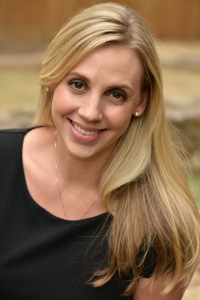 Colleen Oakley is the author of BEFORE I GO, a love story. She’s also a failed triathlete, a margarita enthusiast and a mom to four children. Yes, FOUR. Yes, she’s as shocked about this as anyone. She lives in Atlanta with her husband, the aforementioned kids and the world’s biggest lapdog. As you read this, she is most likely yawning and drinking coffee and putting a child in timeout.
Colleen Oakley is the author of BEFORE I GO, a love story. She’s also a failed triathlete, a margarita enthusiast and a mom to four children. Yes, FOUR. Yes, she’s as shocked about this as anyone. She lives in Atlanta with her husband, the aforementioned kids and the world’s biggest lapdog. As you read this, she is most likely yawning and drinking coffee and putting a child in timeout.








July 28, 2015
A WFW Book Review: My Very Best Friend by Cathy Lamb
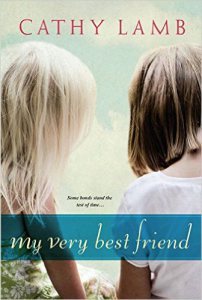 Today is the book birthday for Cathy Lamb’s latest novel MY VERY BEST FRIEND. It’s Cathy’s ninth book, and had me turning the pages late into the night. And if you know me, that’s no small feat. I’m an early-to-bed kinda gal.
Today is the book birthday for Cathy Lamb’s latest novel MY VERY BEST FRIEND. It’s Cathy’s ninth book, and had me turning the pages late into the night. And if you know me, that’s no small feat. I’m an early-to-bed kinda gal.
Sometimes I have an idea what a book is about before I start reading, sometimes not. Even when I do, my expectations of story seem to vanish on page one as I allow the author to do his or her (oh, who are we kidding, usually HER) job.
That’s definitely the case with MY VERY BEST FRIEND.
I was whisked away to the Oregon and the life of Charlotte Mackintosh, a romance writer who has no romance in her life. She’s an odd duck, to say the least, which made her completely endearing. Charlotte is also generous and kind and while she hadn’t traveled in years, she sets off to Scotland to sell her parents’ old cottage, where she lived until she was about twelve. The story takes us then to Scotland–and that’s where the whirlwind begins!
Cathy is a master at pacing. I sometimes felt like I couldn’t keep up with how fast I wanted to read. I’m not sure that makes sense but so much is happening I wanted to take it all in. There’s friendship, heartache, mystery, romance, and some real growth by Charlotte, and all the other characters, by the end of the book.
I read a review somewhere (I am sorry not to attribute its author, but I am not searching for one line in one review!) that said something like the reader learned something new on every page.
SHE LEARNED SOMETHING NEW ON EVERY PAGE.
And there you have it, folks. Always share something new with your reader. What the characters are doing, saying, wanting, needing. Who they’re being, where they’re going, how they’re failing or succeeding.
I’ve read stacks of writing books and interpreted them in a way that benefits my own writing and in ways I believe I’ve helped others. I’ve taken scores of workshops, gotten pages of feedback, and analyzed my own work and others. But this is one of the most helpful thing I’ve ever read. Take it straight to your writer’s heart and leave it there. And read MY VERY BEST FRIEND to see how it’s done.
I think MY VERY BEST FRIEND is, indeed, a prime example of keeping a reader on the edge of her seat in a book that’s not a thriller. It’s women’s fiction with a generous dollop of romance. It’s happy, it’s sad (oh so very), it’s funny, it’s complex (but easy to follow), and it’s also whimsical. I picked up this book when I had time to read and when I should have been doing other things.
What can I say, my friends? Cathy Lamb has done it again.
Amy xo
Lots of ways to buy MY VERY BEST FRIEND right—> here.








July 22, 2015
Guest Post: Author Claire Dyer On Managing Multiple Points Of View In Your Novel
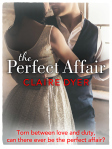 I’m a one POV writer. At least so far. I love multi-POV novels but it’s not something I’ve tackled in my own book-writing journey. Today, author Claire Dyer shares with us some thoughts on writing a novel with multiple points of view. What are your thoughts? How do you do it? Do you stay far away from it? In the past, I’ve used short stories to experiment with POV and different literary devices and techniques. When I was reading Claire’s post I remembered I’d had a short story published that used two points of view…and I went back and read it. It was published a year before The Glass Wives (May 2013) — and I’ll be honest, it took me about a year and a half to find it a home! (So yes, I’ve always been persistent) ;-) Here’s a link if you want to read Minding Joe.
I’m a one POV writer. At least so far. I love multi-POV novels but it’s not something I’ve tackled in my own book-writing journey. Today, author Claire Dyer shares with us some thoughts on writing a novel with multiple points of view. What are your thoughts? How do you do it? Do you stay far away from it? In the past, I’ve used short stories to experiment with POV and different literary devices and techniques. When I was reading Claire’s post I remembered I’d had a short story published that used two points of view…and I went back and read it. It was published a year before The Glass Wives (May 2013) — and I’ll be honest, it took me about a year and a half to find it a home! (So yes, I’ve always been persistent) ;-) Here’s a link if you want to read Minding Joe.
But first — share your many thoughts on managing multiple points of view in the comments.
And please welcome Claire Dyer to WFW!
Amy xo
Managing Multiple Points of View
by Claire Dyer
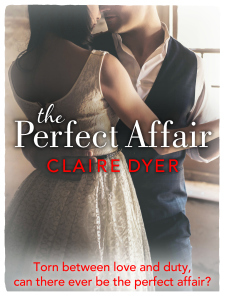 A best-selling author whose books I love once said that when he writes multiple POV novels he writes the stories of his main characters independently from one another and then weaves them together to create the book’s narrative arc.
A best-selling author whose books I love once said that when he writes multiple POV novels he writes the stories of his main characters independently from one another and then weaves them together to create the book’s narrative arc.
I was astonished to hear this because I had never thought of doing it this way! You see, in my multi-POV novels my characters’ stories emerge as I write, they feed off one another, they evolve and change. And, what I love most is spotting the recurring motifs, letting loose their different voices, giving them the space they need, seeing scenes from their varying perspectives and I really doubt I could do all this any other way than writing their stories concurrently.
Of course I scope my characters out beforehand: I give them history, trauma, fault lines and redeeming features; I work within a narrative structure and know roughly how their stories will end. But we’re all in it together from the start. It’s like we’re all in the same mini-bus on the same journey.
Furthermore, I know I couldn’t shift POV mid-scene like Virginia Woolf does so expertly and can’t really see myself in the position of omniscient narrator. When I write I’m inside my characters’ heads, looking out through their eyes; their hearts are beating inside me.
However, is there a right or a wrong way of managing multi POVs? I guess every writer is different and will have their own way of approaching this particular writing conundrum and so, in attempt to plumb this question further, I did what every bemused writer does and consulted the Twitterverse by putting out a plea for help!
The question: ‘Quick straw poll writing peeps, with multi POV novels do you write each character’s story in one go or as you go?’
The answers:
§ Some do it my way by plotting separately and dropping characters in and out as opportunity permits having determined each character’s arc beforehand;
§ another said they’d always written ‘as they go’ but, because of the emotionally complex nature of their current WIP, they’re writing each character separately this time;
§ others do both (which is an awesome feat!);
§ and another said whilst they write the individual POVs concurrently, they read each one back in one go to ensure consistency.
So, is there a right way or a wrong way? I have concluded that, as ever, with writing, it’s each to their own and what is important is to write the way that works for you and, whilst so far I’ve written novels containing multiple POVs over shifting timeframes, I have promised myself that one day, yes, one day, I’ll write a book in the first person with a straight A-Z timeline. But I’m sure this will throw up its own challenges, after all the writing life normally does, doesn’t it?
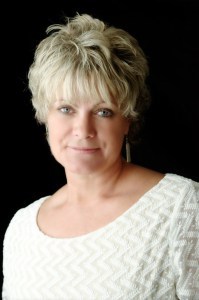 Claire Dyer’s novels The Moment and The Perfect Affair, and her short story, Falling for Gatsby, are published by Quercus. Her poetry collection, Eleven Rooms, is published by Two Rivers Press. Claire has an MA in Creative Writing from Royal Holloway, University of London.
Claire Dyer’s novels The Moment and The Perfect Affair, and her short story, Falling for Gatsby, are published by Quercus. Her poetry collection, Eleven Rooms, is published by Two Rivers Press. Claire has an MA in Creative Writing from Royal Holloway, University of London.
Website: http://www.clairedyer.com
Twitter: @ClaireDyer1
Facebook: Claire Dyer – Author








Women's Fiction Writers
- Amy Sue Nathan's profile
- 543 followers


